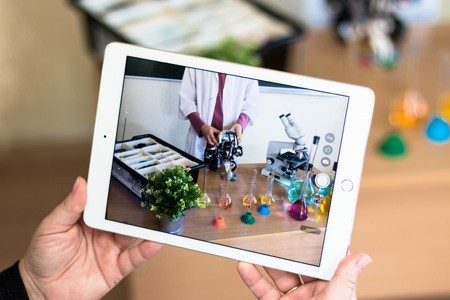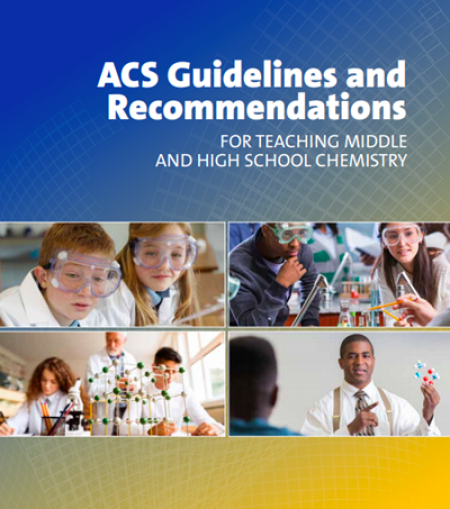Technology In the Classroom
Technology has transformed education and our society. Cell phones, projectors, wireless Internet access, interactive whiteboards, graphing calculators, laptop computers, tablets, and other evolving technologies are among the devices available to use in a chemistry classroom. If used appropriately, these tools can enhance student-centered instruction.
Furthermore, with the advancement of social media, chemistry classrooms can easily access new findings and information that can deepen conversation and put chemistry into action. Students should be introduced to the concept of information literacy when using the Internet to research pre-lab assignments or experimental results. The use of primary literature and determining a “good” website should be promoted.
Benefits of Technology
- Various forms of computerized assessments allow students and teachers to obtain immediate feedback of student understanding.
- Many assistive technologies, such as those from the Center for Applied Special Technology, are available to enhance the learning experience for students with disabilities.
- Educational technology has the power to enhance communication. Students and teachers can access research and resources beyond the walls of their school and share paperless reports that are rich in content.
- Lab results and videos of activities can be shared, reused, and analyzed. This is helpful for data analysis or catching students up when they miss class.
- Teachers can access professional development via webinars, communicate with students and parents over email and social media, and interact online with colleagues throughout the world in real time from their classroom desks.
- Sites like Twitter and Facebook are helpful; teachers can join professional learning networks to gain ideas, get feedback, and discuss practices and policies. Furthermore, using educational blogs and chemistry-related YouTube channels can help teachers share current events with students and gain new ideas to incorporate into their own curriculum.
Staying Current
Consult your school’s technology department, department chair, or appropriate personnel to identify what may work best for you and your students, and within the constraints of your school. With many schools being cognizant about the platforms available, safe internet usage, internet speed, and digital citizenship, teachers should be informed of their school’s policies and adhere to them.
Be proactive about staying current on the ever-evolving tools of educational technology and choose those that can add value to the chemistry curriculum. Since emerging technologies come out often, teachers should check different websites, like the Office of Educational Technology, to ensure that the tools they are using to engage and inspire their students are up-to-date and appropriate.
Technology in the Lab
Laboratory activities may be performed with data collection instruments that interface directly with computers or calculators. For example, digital sensors can be used for pH testing and water quality analysis. Once collected, these data are displayed on clearly labeled graphs, and students can easily interpret data.
At the high school chemistry level, advanced data analysis can take place with the help of technology. From digitally collected data, students can generate regression equations and lines of best fit to allow for interpolation and extrapolation to draw conclusions. The Journal of Chemical Education, The Science Teacher, and Mathematics Teacher journals are sources of investigations that use these devices, many of which may be used on a smaller scale—resulting in less waste and greater safety (see Environmental Considerations).
Videos of lab apparatus or advanced lab techniques can be created to assist students with a new experiment or method. Or if a student is absent from class the day of an experiment or demonstration, a video can provide him or her with the visual experience that other students we exposed to.
With access to shared documents, class data sets may be collected for more accurate data analysis. For example, when conducting a titration, a class set of data can easily be generated and shared. This provides students an opportunity to consider erroneous data points within a large set of data, rather than the limited two or three trials they conducted.
Although the use of technology is crucial to provide students with a modern education, it is important for students to understand the underlying chemistry principles and be able to articulate them.
When to Substitute a Hands-On Lab
Some experiments are too hazardous or impractical to be a hands-on investigation, in which case a teacher-led demonstration may be a suitable substitute. Other experiments may be too costly, or require obscure resources. Those can be viewed on video. Thermite reactions, for instance, could be witnessed on a screen, eliminating the associated danger and required safety equipment. In a middle school classroom, many videos of hazardous chemical demonstrations are a great tool to engage budding young chemists.
Some concepts are difficult to investigate on a macroscale using chemicals. Computer simulations are available for students to use on both the Internet and as applications on a tablet. For example, the University of Colorado, Boulder, offers a number of age-appropriate chemistry simulations on its PhET website, and Concord Consortium is a good source of simulations. These simulations typically investigate what happens on the atomic level via computer-generated models of molecular motion and interactions.
When able, it is important to emphasize that hands-on laboratory experiences are critical to a quality chemistry curriculum and, as ACS recommends, that technology should not be a replacement for the laboratory experience, but rather an enhancement.
ACS Guidelines and Recommendations
for Teaching Middle and High School Chemistry
An essential resource for middle and high school physical science and chemistry teachers, curriculum developers, principals, and other school administrators who support teachers in those roles.
Learn about the nature of instruction, the core ideas to teach, the physical instructional environment, safety, sustainability, and the professional responsibilities of teachers.



